Raising Climate-Resilient Embolden Rice (Oryza sativa L.) Seedlings during the Cool Season through Various Types of Nursery Bed Management
Abstract
1. Introduction
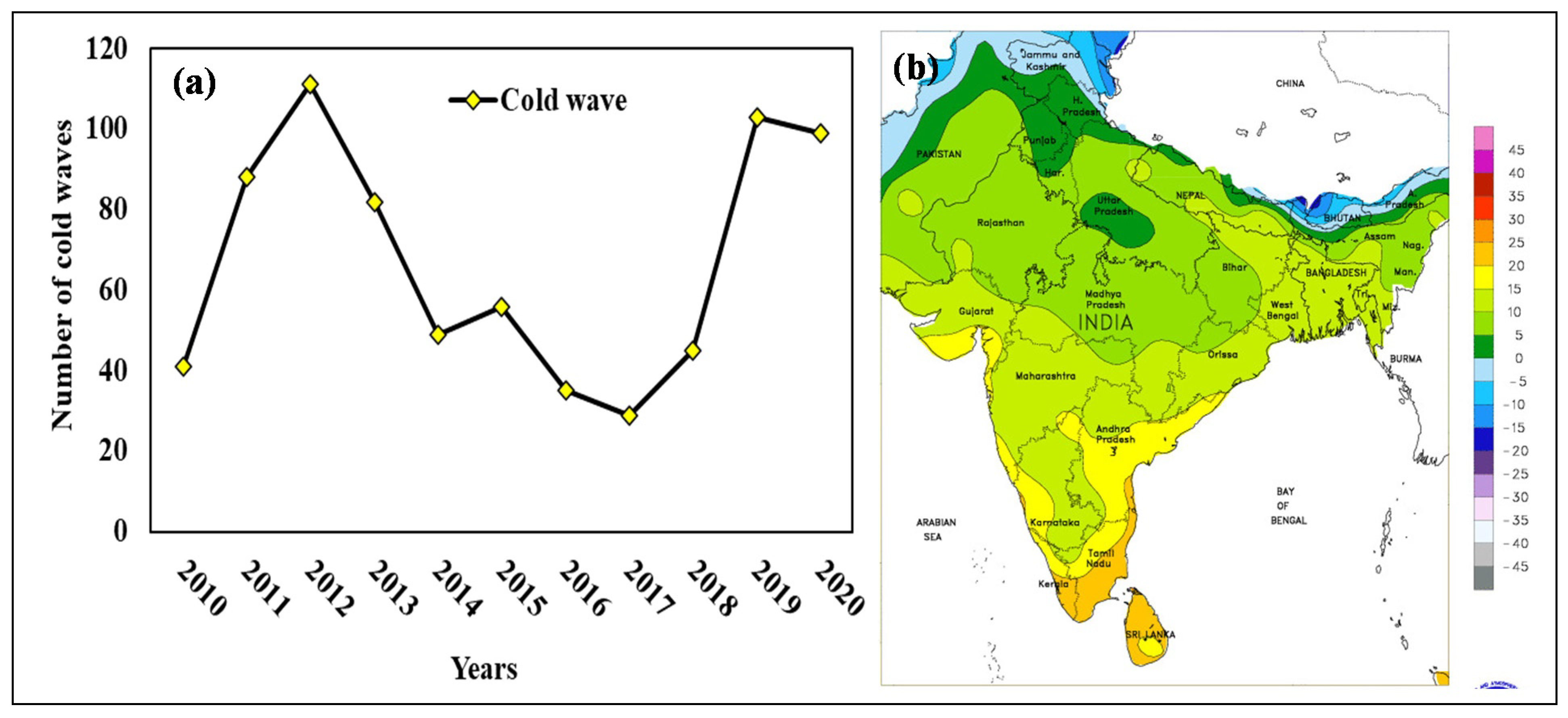
2. Materials and Methods
2.1. Experimental Site
2.2. Climatic Condition
2.3. Edaphic Condition
2.4. Details of the Experiment
2.4.1. Treatment Details and Statistical Design
2.4.2. Germination of Seeds
2.4.3. Preparation of Nursery Bed
Conventional Nursery Bed
Improved Nursery Bed
2.4.4. Measurement and Analytical Procedure
Biometric Observations
Temperature and Relative Humidity
Nutrient Assessment
Chlorophyll Content
Cost of Production
Energy Budgeting
Statistical Analysis
3. Results
3.1. Micro-Climatic Condition
3.2. Growth Attributes
3.3. Nutrient Uptake
3.4. Chlorophyll Content
3.5. Input Use
3.6. Age of Seedling Transplantation
3.7. Cost of Production
3.8. Energy Budgeting
4. Discussions
5. Conclusions
Author Contributions
Funding
Institutional Review Board Statement
Informed Consent Statement
Data Availability Statement
Acknowledgments
Conflicts of Interest
Abbreviations
| N | Nitrogen |
| P | Phosphorous |
| K | Potassium |
| SDGs | sustainable development goals |
| Mt | Million tonnes |
| Mha | Million hectare |
| Zn | Zinc |
| B | Boron |
| C | Carbon |
| °C | Degree centigrade |
| cm | centimetre |
| m | Metre |
| lit | Litre |
| h | Hours |
| FYM | Farm Yard Manure |
| t | Tonne |
| DAS | Days after sowing |
| MG | Mega-Joule |
Appendix A
| Item | Unit | Energy (MJ) |
|---|---|---|
| Human labour (Adult man) | Man-hour | 1.96 |
| Bullocks (Medium) | Pair-hour | 10.10 |
| Diesel | Litre | 56.31 |
| Machinery | kg | 64.80 |
| FYM | tonne | 300 |
| N | kg | 60.60 |
| P2O5 | kg | 11.10 |
| K2O | kg | 6.70 |
| Zn | kg | 120 |
| B | kg | 120 |
| Rice seed | kg | 14.7 |
| Polythene mulching | Pound (lb) | 20.99 |
References
- FAO. FAOSTAT Database Collections. Food and Agriculture Organization of the United Nations: Rome. 2021. Available online: http://www.fao.org/faostat/en/#data/QC/visualize (accessed on 6 July 2021).
- Muthayya, S.; Sugimoto, J.D.; Montgomery, S.; Maberly, G.F. An overview of global rice production, supply, trade, and consumption. Ann. N. Y. Acad. Sci. 2014, 1324, 7–14. [Google Scholar] [CrossRef]
- Biswas, B.; Chakraborty, D.; Timsina, J.; Roy, D.P.D.; Adhikary, S.; Das, I.; Sarkar, A.; Ray, B.R.; Sarkar, S.; Mondal, M.; et al. Replacing winter rice in non-traditional areas by strawberry reduces arsenic bioaccumulation, and improves water productivity and profitability. Sci. Total Environ. 2021, 788, 147810. [Google Scholar] [CrossRef] [PubMed]
- Biswas, B.; Timsina, J.; Garai, S.; Mondal, M.; Banerjee, H.; Adhikary, S.; Kanthal, S. Weed control in transplanted rice with post-emergence herbicides and their effects on subsequent rapeseed in Eastern India. Int. J. Pest Manag. 2020. [Google Scholar] [CrossRef]
- GOI. Agricultural Statistics at Glance. In Government of India, Ministry of Agriculture, Cooperation and Farmers Welfare, Directorate of Economics and Statistics; GOI: New Delhi, India, 2019; Available online: https://agricoop.nic.in/en/annual-report (accessed on 15 April 2021).
- Sudhir-Yadav; Kumar, V.; Singh, S.; Kumar, R.M.; Sharma, S.; Tripathi, R.; Nayak, A.; Ladha, J.K. Growing Rice in Eastern India: New Paradigms of risk reduction and improving productivity. In The Future Rice Strategy for India; Mohanty, S., Chengappa, P., Mruthunjaya, H., Ladha, J.K., Baruah, S., Kannan, E., Manjunatha, A.V., Eds.; Elsevier: London, UK, 2017; pp. 221–258. [Google Scholar]
- Banerjee, H.; Samanta, S.; Sarkar, S.; Garai, S.; Pal, S.; Brahmachari, K. Growth, Productivity and Nutrient Uptake of Different Rice Cultivars under Coastal Eco-System of West Bengal. J. Indian Soc. Coast. Agric. Res. 2018, 36, 115–121. [Google Scholar]
- Kundu, R.; Mondal, M.; Garai, S.; Mondal, R.; Poddar, R. Bio-efficacy of post emergence herbicides in boro rice nursery as well as main field and their residual effects on non-target microorganisms. Oryza 2020, 57, 199–210. [Google Scholar] [CrossRef]
- Priyanka, K.; Jaiswal, H.K. Effect of cold stress on boro rice seedlings. J. Appl. Nat. Sci. 2017, 9, 1036–1041. [Google Scholar]
- Pathak, A.K.; Pathak, P.K.; Sharma, K.K. Recent Development in Boro Rice Improvement and Production for Raising Rice Yield in Assam. In Boro Rice; Singh, R.K., Hossain, M., Thakur, R., Eds.; International Rice Research Institute: New Delhi, India, 2003; pp. 73–80. [Google Scholar]
- Yoshida, S. Fundamentals of Rice Crop Science; International Rice Research Institute: Los Baňos, Phillipines, 1981; pp. 1–63. [Google Scholar]
- Basuchaudhuri, P. Cold Tolerance in Rice Cultivation, 1st ed.; CRC Press: Boca Raton, FL, USA; Taylor & Francis Group: Boca Raton, FL, USA, 2014; pp. 1–210. [Google Scholar]
- Sharma, N.; Reinke, R.; Sacks, E.J. Comparison of Methods toEvaluate Rice (Oryzasativa) Germplasm for Tolerance to Low Temperature at the Seedling Stage. Agronomy 2021, 11, 385. [Google Scholar] [CrossRef]
- Suh, J.P.; Lee, C.K.; Lee, J.H.; Kim, J.J.; Kim, S.M.; Cho, Y.C.; Park, S.H.; Shin, J.C.; Kim, Y.G.; Jena, K.K. Identification of quantitative trait loci for seedling cold tolerance using RILs derived from a cross between japonica and tropical japonica rice cultivars. Euphytica 2012, 184, 101–108. [Google Scholar] [CrossRef]
- Biswas, B.; Timsina, J.; Patra, S.R.; De, D.; Mishra, B.; Chakraborti, R.; Patra, A.; Mahato, B.; Banerjee, P.; Ghosh, P.K.; et al. Climate Change-Resilient Rice Production Technology: A High Yielding, Water Efficient and Remunerative Option for South Asian Farmers. GJAAS 2019, 1, 20–29. [Google Scholar] [CrossRef]
- Liu, Q.; Zhou, X.; Li, J.; Xin, C. Effects of seedling age and cultivation density on agronomic characteristics and grain yield of mechanically transplanted rice. Sci. Rep. 2017, 7, 14072. [Google Scholar] [CrossRef] [PubMed]
- Mondal, M.; Skalicky, M.; Garai, S.; Hossain, A.; Sarkar, S.; Banerjee, H.; Kundu, R.; Brestic, M.; Barutcular, C.; Erman, M.; et al. Supplementing Nitrogen in Combination with Rhizobium Inoculation and Soil Mulch in Peanut (Arachishypogaea L.) Production System: Part I. Effects on Productivity, Soil Moisture, and Nutrient Dynamics. Agronomy 2020, 10, 1582. [Google Scholar] [CrossRef]
- Ajeigbe, H.A.; Kamara, A.Y.; Kunhiya, A.; Inuwa, A.H.; Adinoyi, A. Response of Groundnut to Plant Density and Phsophorus Application in the Sudan Savanna Zone of Nigeria. Int. J. Biosci. 2016, 9, 291–320. [Google Scholar]
- Mondal, M.; Skalicky, M.; Garai, S.; Hossain, A.; Sarkar, S.; Banerjee, H.; Kundu, R.; Brestic, M.; Barutcular, C.; Erman, M.; et al. Supplementing Nitrogen in Combination with Rhizobium Inoculation and Soil Mulch in Peanut (Arachishypogaea L.) Production System: Part II. Effect on Phenology, Growth, Yield Attributes, Pod Quality, Profitability and Nitrogen Use Efficiency. Agronomy 2020, 10, 1513. [Google Scholar] [CrossRef]
- Mondal, M.; Garai, S.; Banerjee, H.; Sarkar, S. Mulching and nitrogen management in peanut cultivation: An evaluation of productivity, energy trade-off, carbon footprint and profitability. Energy. Ecol. Environ. 2020, 6, 133–147. [Google Scholar] [CrossRef]
- Begum, M.K.; Kader, M.A.; Hossain, S.M.A.; Hasan, K.M. Effect of seedling raising method and fertilizer combination on the yield of late boro rice. Pak. J. Agron. 2002, 1, 89–91. [Google Scholar] [CrossRef]
- Kilic, H. The effect of planting methods on yield and yield components of irrigated spring durum wheat varieties. Sci. Res. Essays 2010, 5, 3063–3069. Available online: http://www.academicjournals.org/SRE (accessed on 10 October 2021).
- Mishra, A.; Salokhe, V.M. Seedling characteristics and the early growth of transplanted rice under different water regimes. J. Exp. Agric. 2008, 44, 1–19. [Google Scholar] [CrossRef]
- Statista. Available online: https://www.statista.com/statistics/1006969/india-number-of-cold-waves/ (accessed on 6 July 2021).
- Sharma, B.K.; Islam, M.S. Nursery Management in boro rice Seedling through different dates of Sowing. Int. Arch. App. Sci. Technol. 2020, 11, 156–160. [Google Scholar]
- Bouyoucos, G.J. Hydrometer method improved for making particle size analyses of soils. Agron. J. 1962, 54, 464–465. [Google Scholar] [CrossRef]
- Brady, N.C.; Weil, R.R. The Nature and Properties of Soils; Prentice Hall Inc: Hoboken, NJ, USA, 1996; pp. 1–1071. [Google Scholar]
- Jackson, M.L. Soil Chemical Analysis; Prentice-Hall of India Pvt. Ltd.: New Delhi, India, 1967; pp. 1–498. [Google Scholar]
- Walkley, A.J.; Black, I.A. An examination of the Degtjareff method for determining soil organic matter, and a proposed modification of the chromic acid titration method. Soil Sci. 1934, 37, 29–38. [Google Scholar] [CrossRef]
- Subbiah, B.V.; Asija, G.L. A rapid procedure for estimation of available nitrogen in soil. Curr. Sci. 1956, 25, 259–260. [Google Scholar]
- Olsen, S.R.; Cole, C.V.; Watanabe, F.S.; Dean, L.A. Estimation of available phosphorous in soil by extraction with sodium bicarbonate. USDA Circ. 1954, 939, 1–19. [Google Scholar]
- Hanway, J.J.; Heidel, H. Soil analysis methods as used in Iowa State College Soil Testing Laboratory. Iowa State Coll. Agric. Bull. 1952, 57, 1–13. [Google Scholar]
- Garai, S.; Brahmachari, K.; Sarkar, S.; Kundu, R.; Pal, M.; Pramanick, B. Crop Growth and Productivity of Rainy Maize-garden Pea Copping Sequence as Influenced by Kappaphycus and Gracilaria Saps at Alluvial Soil of West Bengal, India. Curr. J. Appl. Sci. Technol. 2019, 36, 1–11. [Google Scholar] [CrossRef][Green Version]
- Olasupo, F.O.; Ilori, C.O.; Forster, B.P.; Bado, S. Mutagenic Effects of Gamma Radiation on Eight Accessions of Cowpea (Vignaunguiculata [L.] Walp.). Am. J. Plant Sci. 2016, 7, 339–351. [Google Scholar] [CrossRef]
- Kundu, R.; Mondal, M.; Garai, S.; Banerjee, H.; Ghosh, D.; Majumder, A.; Poddar, R. Efficacy of herbicides on weed control, rhizospheric micro-organisms, soilproperties and leaf qualities in tea plantation. Indian J. Weed Sci. 2020, 52, 160–168. [Google Scholar] [CrossRef]
- IRRI. Statistical tool for agricultural research, Version 2.0.1. In User’s Manual. Biometrics and Breeding Informatics; PBGB, Division, International Rice Research Institute: Los Bãnos, Philippines, 2013. [Google Scholar]
- Azhiri-Sigari, T.; Desamero, N.V.; Cabigat, J.C.; Abayao, E.H. Seedbed & Seedling Management in the Ifugao Rice Terraces. Philipp. J. Crop. Sci. 2004, 29, 45–50. [Google Scholar]
- Kumar, A.; Reddy, M.D. Effect of nursery seeding date and phosphorus fertilization on rice seedling growth. IRRN 2003, 282, 50–52. [Google Scholar]
- Shah, M.H.; Amarjit, S.B.; Bali, A.S.; Singh, K.N. Studies on sowing dates and systems of rice nursery raising to combat cold injury in temperate Kashmir. Oryza 2000, 37, 96–99. [Google Scholar]
- Rautaray, S.K. Effect of nursery density and polythene tunnel on seedling vigour and yield of Boro rice (Summer) in lower Assam. Indian Farming 2003, 53, 28–31. [Google Scholar]
- Yoshida, S. Tropical Climate and Its Influence on Rice; IRRI: Los Banos, Philippines, 1978. [Google Scholar]
- Maheswari, J.; Margatham, N.; Martin, G.J. Relatively simple irrigation scheduling and N application enhances the productivity of aerobic rice (Oryzasativa). Am. J. Plant Physiol. 2007, 2, 261–268. [Google Scholar] [CrossRef]
- Rashid, M.M.; Yasmeen, R. Cold Injury and Flash Flood Damage in Boro Rice Cultivation in Bangladesh: A Review. Bangladesh Rice J. 2017, 21, 13–25. [Google Scholar] [CrossRef]
- Aghaee, A.; Moradi, F.; Zare-Maivan, H.; Zarinkamar, F.; Irandoost, H.P.; Sharifi, P. Physiological responses of two rice (Oryzasativa L.) genotypes to chilling stress at seedling stage. Afr. J. Biotechnol. 2011, 10, 7617–7621. [Google Scholar]
- Jan, M.; Shinwari, K.I.; Shah, G.; Khan, M.H.U.; Ullah, S.; Hameed, A.; Malook, I. Consequences of short-term low temperature stress on physiological and biochemical aspects of rice (Oryzasativa L.). Sci. Agric. 2015, 10, 1–14. [Google Scholar]
- Yadegari, L.Z.; Heidari, R.; Carapetian, J. The influence of cold acclimation on proline, malondialdehyde (MDA), total protein and pigments contents in soybean (Glycine max) seedling. J. Biol. Sci. 2007, 7, 1141–1436. [Google Scholar] [CrossRef][Green Version]
- Petrov, P.I.; Kocheva, K.V.; Petrova, A.S.; Georgiev, G.I. Ion leakage and leaf anatomy of barley plants subjected to dehydration. Genet. Plant Physiol. 2015, 2, 15–23. [Google Scholar]
- Jahan, M.S.; Nozulaidi, M.B.N.; Moneruzzaman, M.K.; Ainun, A.; Husna, N. Control of plant growth and water loss by a lack of light-harvesting complexes in photosystem-II in Arabidopsis thaliana ch1-1 mutant. Acta Physiol. Plant. 2014, 36, 1627–1635. [Google Scholar] [CrossRef]
- Yamada, T.; Jones, E.S.; Congan, N.O.; Vecchies, A.C.; Nomura, T.; Hisano, H. QTL analysis of morphological, developmental, and winter hardiness-associated traits in perennial ryegrass. Crop. Sci. 2004, 44, 925–935. [Google Scholar]
- Habibi, F.; NormahamadiSharifabad, H.; Eivazi, A.; Heravan, M. Effect of cold stress on cell mem-brane stability, chlorophyll a and b contain and proline accumulation in wheat (Triticumaiestivum L.) variety. Afr. J. Agric. Res. 2011, 6, 5854–5859. [Google Scholar] [CrossRef]
- Kabir, M.S.; Howlader, M.; Biswas, J.K.; Mahbub, M.A.A.; Nur-E-Elahi, M. Probability of Low Temperature Stress at Different Growth Stages of Boro Rice. Bangladesh Rice J. 2015, 19, 19–27. [Google Scholar] [CrossRef][Green Version]
- Nadeem, F.; Farooq, M. Application of micronutrients in rice-wheat cropping systems of South Asia: A review. Rice Sci. 2019, 26, 356–371. [Google Scholar] [CrossRef]
- Khan, M.U.; Qasim, M.; Subhan, M.; Ahmad, R.D.; Ali, L. Effect of zinc application by different methods on the chemical composition and grain quality of rice. Pak. J. Appl. Sci. 2003, 3, 530–536. [Google Scholar] [CrossRef][Green Version]
- Zulfiqar, U.; Hussain, S.; Ishfaq, M.; Matloob, A.; Ali, N.; Ahmad, M.; Alyemeni, M.N.; Ahmad, P. Zinc-Induced Effects on Productivity, Zinc Use Efficiency, and Grain Biofortification of Bread Wheat under Different Tillage Permutations. Agronomy 2020, 10, 1566. [Google Scholar] [CrossRef]
- Lampayan, R.; Xangsayasane, P.; Bueno, C. Crop performance and water productivity of transplanted rice as affected by seedling age and seedling density under alternate wetting and drying conditions in Lao PDR. Water 2019, 11, 1816. [Google Scholar] [CrossRef]
- Zahedi, M.; Mondani, F.; Eshghizadeh, H.R. Analyzing the energy balances of double-cropped cereals in an arid region. Energy Rep. 2015, 1, 43–49. [Google Scholar] [CrossRef]
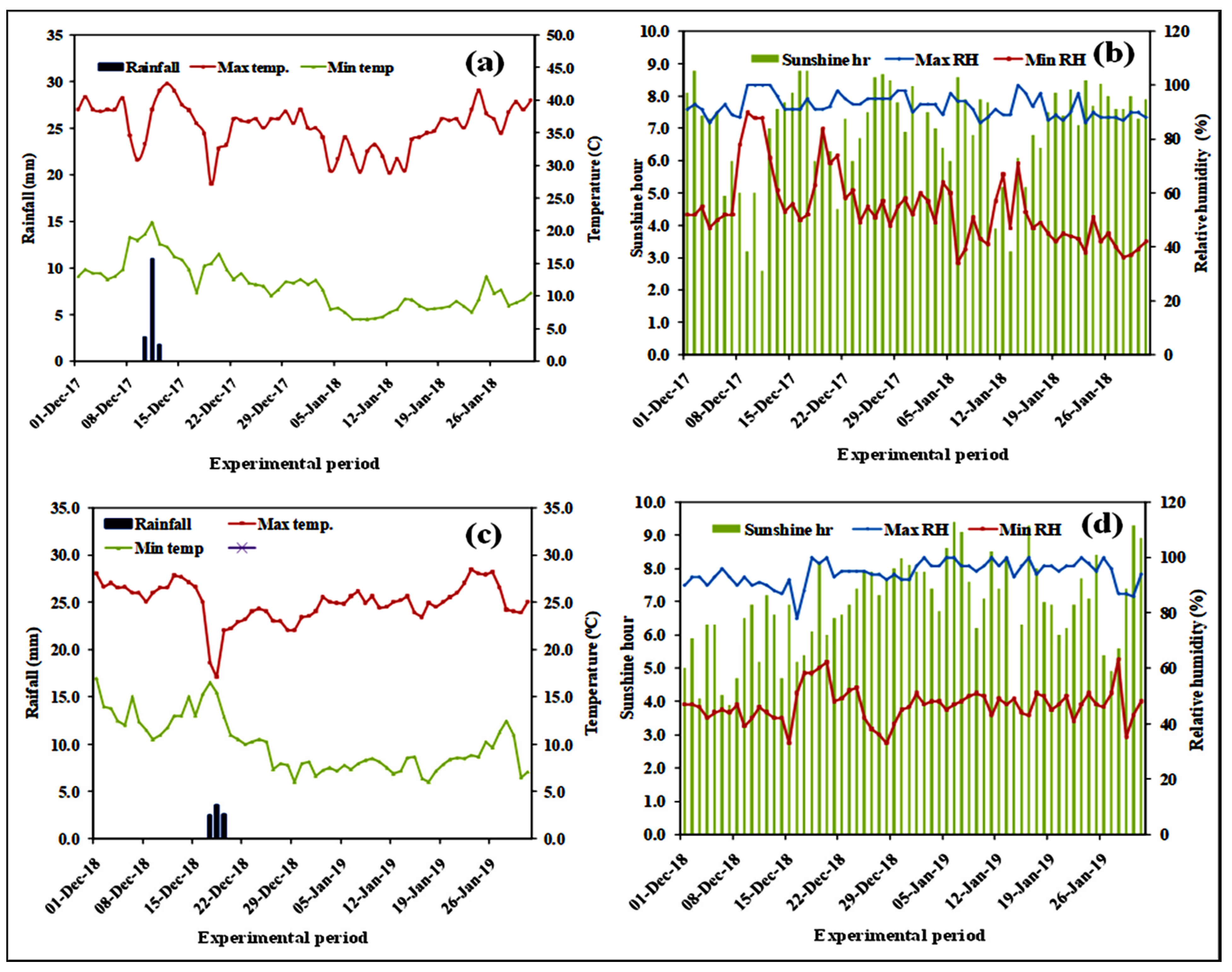
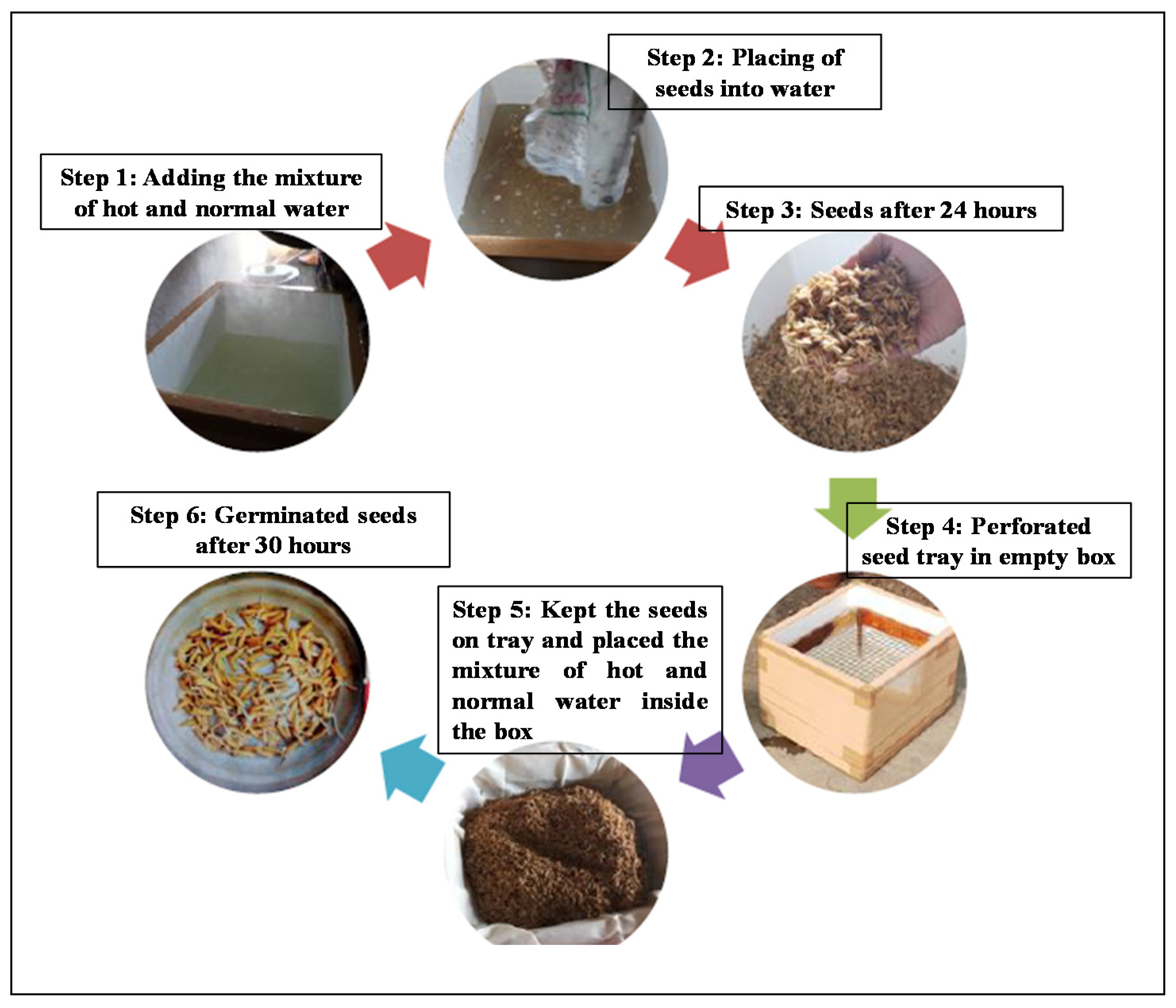


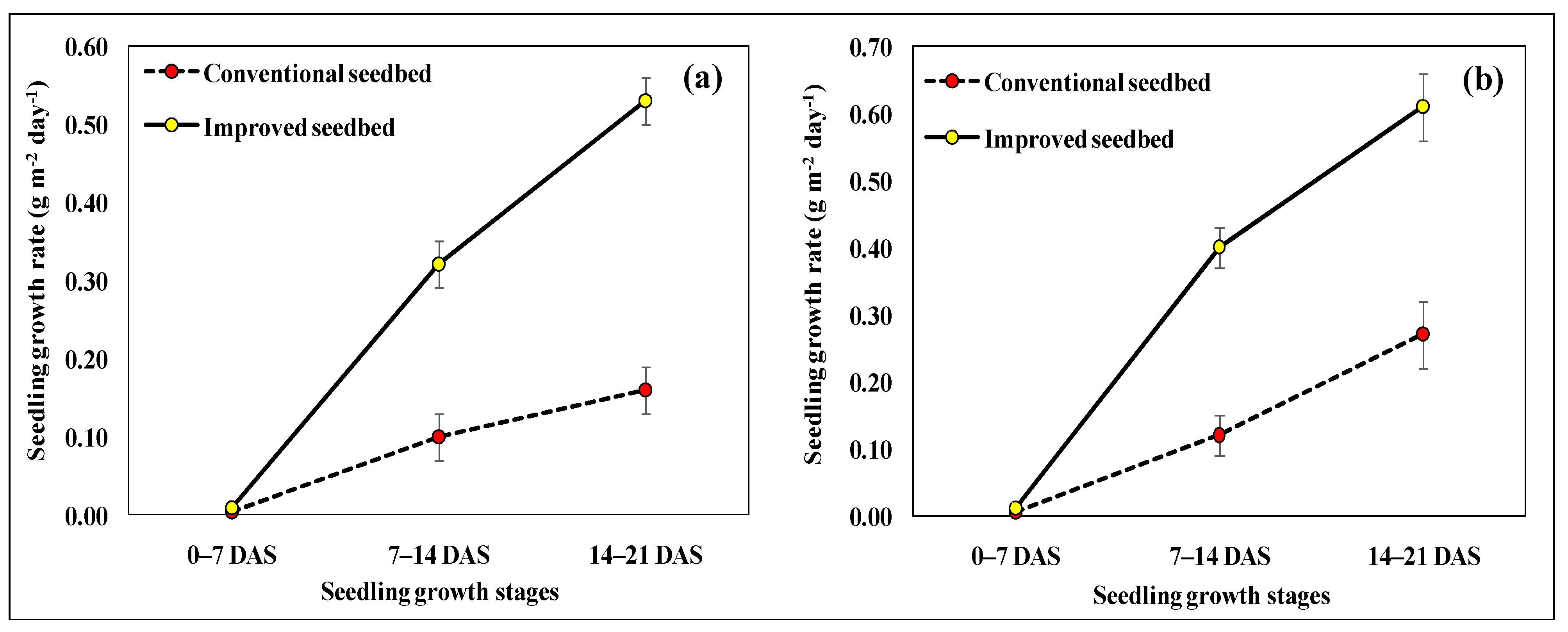
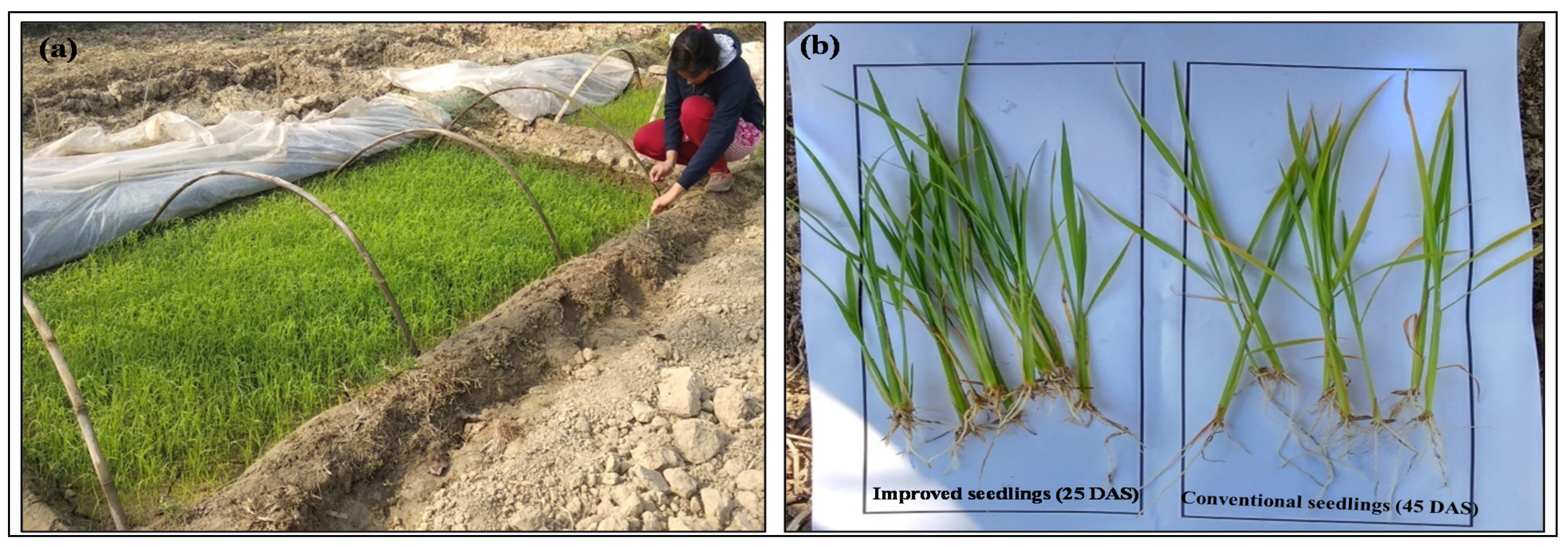
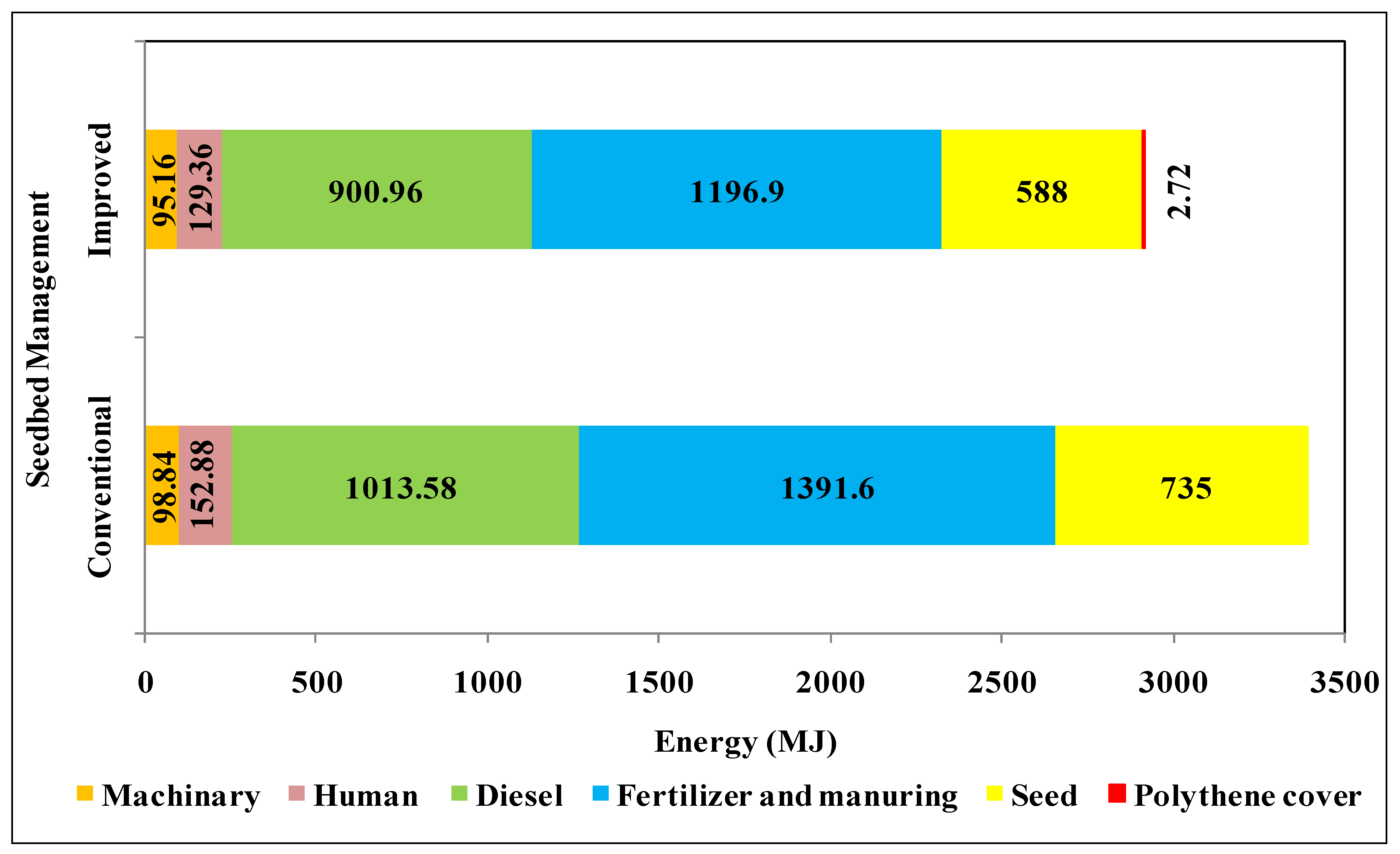
| Particulars | Unit | Value | Method | |
|---|---|---|---|---|
| 2017–2018 | 2018–2019 | |||
| Physical properties | ||||
| Sand | (%) | 35.2 | 36.2 | Hydrometer method [26] |
| Silt | (%) | 26.4 | 28.2 | |
| Clay | (%) | 36.4 | 38.0 | |
| Soil texture | - | Clay-loam (Illite dominant) | Clay-loam (Illite dominant) | Textural triangular method Brady and Weil [27] |
| Chemical properties | ||||
| pH | - | 7.61 | 7.26 | μ-processor-based pH-EC-Ion meter [28] |
| Organic C | (%) | 0.58 | 0.51 | [29] |
| Available N | kg ha−1 | 216.0 | 195.3 | Hot alkaline KMnO4 Method [30] |
| Available P | kg ha−1 | 37.2 | 48.6 | 0.5M NaHCO3 extract [31] |
| Available K | kg ha−1 | 176.4 | 184.3 | Neutral N NH4OAc extract [32] |
| Treatment Details | Seedling Emergence (%) | Seedling Height (cm) | Above-Ground Biomass (g Seedling−1) | |||||||||||
|---|---|---|---|---|---|---|---|---|---|---|---|---|---|---|
| Y1 | Y2 | 7 DAS | 14 DAS | 21 DAS | 7 DAS | 14 DAS | 21 DAS | |||||||
| Y1 | Y2 | Y1 | Y2 | Y1 | Y2 | Y1 | Y2 | Y1 | Y2 | Y1 | Y2 | |||
| Conventional | 71.00 | 66.00 | 1.10 | 1.53 | 3.70 | 2.97 | 5.93 | 7.16 | 0.03 | 0.04 | 0.73 | 0.85 | 1.85 | 2.72 |
| Improved | 90.00 | 91.00 | 2.80 | 3.94 | 8.00 | 9.67 | 13.33 | 14.60 | 0.06 | 0.08 | 2.19 | 2.88 | 6.04 | 7.14 |
| SEm ± | 2.38 | 3.06 | 0.19 | 0.41 | 0.65 | 0.34 | 0.62 | 0.35 | 0.01 | 0.01 | 0.19 | 0.23 | 0.33 | 0.43 |
| LSD (p ≤ 0.05) | ** | ** | ** | ** | ** | ** | ** | ** | * | ** | ** | ** | ** | ** |
| Treatments | Root Dry Weight (g Seedling−1) | Root Length (mm Seedlings−1) | Root: Shoot Ratio | |||||||||||||||
|---|---|---|---|---|---|---|---|---|---|---|---|---|---|---|---|---|---|---|
| 7 DAS | 14 DAS | 21 DAS | 7 DAS | 14 DAS | 21 DAS | 7 DAS | 14 DAS | 21 DAS | ||||||||||
| Y1 | Y2 | Y1 | Y2 | Y1 | Y2 | Y1 | Y2 | Y1 | Y2 | Y1 | Y2 | Y1 | Y2 | Y1 | Y2 | Y1 | Y2 | |
| Conventional | 0.01 | 0.02 | 0.16 | 0.25 | 0.82 | 0.97 | 9.0 | 9.0 | 14.1 | 15.3 | 22.0 | 20.0 | 0.82 | 0.59 | 0.38 | 0.52 | 0.37 | 0.28 |
| Improved | 0.04 | 0.05 | 0.77 | 0.81 | 1.90 | 2.09 | 11.2 | 11.0 | 39.8 | 40.3 | 59.5 | 62.3 | 0.40 | 0.28 | 0.50 | 0.42 | 0.45 | 0.43 |
| SEm ± | 0.01 | 0.01 | 0.09 | 0.12 | 0.17 | 0.09 | 0.7 | 0.8 | 0.9 | 1.2 | 1.9 | 2.4 | - | - | - | - | - | |
| LSD (p ≤ 0.05) | ns | * | ** | ** | ** | ** | * | ns | ** | ** | ** | ** | - | - | - | - | - | - |
| Treatment Details | Tillers (no. Seedling−1) | Days to Leaf Emergence | Leaves (no. Seedling−1) | |||||||||||||||
|---|---|---|---|---|---|---|---|---|---|---|---|---|---|---|---|---|---|---|
| 14 DAS | 21 DAS | 1st Leaf | 2nd Leaf | 3rd Leaf | 4th Leaf | 7 DAS | 14 DAS | 21 DAS | ||||||||||
| Y1 | Y2 | Y1 | Y2 | Y1 | Y2 | Y1 | Y2 | Y1 | Y2 | Y1 | Y2 | Y1 | Y2 | Y1 | Y2 | Y1 | Y2 | |
| Conventional | 0.80 | 0.65 | 1.15 | 1.21 | 9 | 10 | 15 | 19 | 21 | 25 | 30 | 33 | 1.10 | 1.93 | 2.37 | 2.97 | 3.02 | 1.10 |
| Improved | 1.13 | 1.24 | 1.53 | 1.68 | 5 | 5 | 8 | 9 | 16 | 15 | 22 | 21 | 1.80 | 2.93 | 3.00 | 3.97 | 3.73 | 1.80 |
| SEm ± | 0.07 | 0.11 | 0.04 | 0.09 | 0.94 | 0.67 | 0.82 | 0.88 | 1.05 | 0.75 | 0.67 | 1.20 | 0.18 | 0.09 | 0.19 | 0.09 | 0.16 | 0.18 |
| LSD (p ≤ 0.05) | ** | ** | ** | ** | ** | ** | ** | ** | ** | ** | ** | ** | ** | ** | ** | ** | ** | ** |
| Treatment Details | Survival% | Seedling m−2 | ||
|---|---|---|---|---|
| Y1 | Y2 | Y1 | Y2 | |
| Conventional | 71.67 | 60.33 | 561 | 527 |
| Improved | 87.33 | 85.67 | 675 | 656 |
| SEm ± | 2.49 | 2.21 | 8.21 | 14.46 |
| LSD (p ≤ 0.05) | ** | ** | ** | ** |
| Treatment Details | N (%) | P (%) | K (%) | |||
|---|---|---|---|---|---|---|
| Y1 | Y2 | Y1 | Y2 | Y1 | Y2 | |
| Conventional | 1.81 | 1.78 | 0.38 | 0.36 | 2.50 | 2.58 |
| Improved | 2.07 | 2.07 | 0.48 | 0.41 | 3.04 | 2.88 |
| SEm ± | 0.07 | 0.08 | 0.02 | 0.05 | 0.10 | 0.06 |
| LSD (p ≤ 0.05) | * | ** | * | ns | * | ** |
| Treatment Details | 7 DAS | 14 DAS | 21 DAS | |||
|---|---|---|---|---|---|---|
| Y1 | Y2 | Y1 | Y2 | Y1 | Y2 | |
| Conventional seedbed | 0.24 | 0.32 | 0.77 | 0.64 | 1.71 | 1.63 |
| Improved seedbed | 0.51 | 0.52 | 1.05 | 1.08 | 2.22 | 2.02 |
| SEm ± | 0.03 | 0.03 | 0.08 | 0.06 | 0.06 | 0.06 |
| LSD (p ≤ 0.05) | ** | ** | * | ** | ** | ** |
| Treatment Details | Labour Requirement (Working Days) | Irrigation Application (h) | Seedling Age for Transplantation (Days) | Cost Involvement (Rs ha−1) | Energy Involvement (MJ ha−1) | |||||
|---|---|---|---|---|---|---|---|---|---|---|
| Y1 | Y2 | Y1 | Y2 | Y1 | Y2 | Y1 | Y2 | Y1 | Y2 | |
| Conventional | 11 | 11 | 4 | 4 | 45 | 45 | 5171.12 | 5507.12 | 3391.70 | 3391.70 |
| Improved | 6 | 6 | 2 | 2 | 25 | 25 | 2233.00 | 2425.00 | 2910.38 | 2910.38 |
Publisher’s Note: MDPI stays neutral with regard to jurisdictional claims in published maps and institutional affiliations. |
© 2021 by the authors. Licensee MDPI, Basel, Switzerland. This article is an open access article distributed under the terms and conditions of the Creative Commons Attribution (CC BY) license (https://creativecommons.org/licenses/by/4.0/).
Share and Cite
Mondal, M.; Biswas, B.; Garai, S.; Adhikary, S.; Bandyopadhyay, P.K.; Sarkar, S.; Banerjee, H.; Brahmachari, K.; Maitra, S.; Mandal, T.K.; et al. Raising Climate-Resilient Embolden Rice (Oryza sativa L.) Seedlings during the Cool Season through Various Types of Nursery Bed Management. Sustainability 2021, 13, 12910. https://doi.org/10.3390/su132212910
Mondal M, Biswas B, Garai S, Adhikary S, Bandyopadhyay PK, Sarkar S, Banerjee H, Brahmachari K, Maitra S, Mandal TK, et al. Raising Climate-Resilient Embolden Rice (Oryza sativa L.) Seedlings during the Cool Season through Various Types of Nursery Bed Management. Sustainability. 2021; 13(22):12910. https://doi.org/10.3390/su132212910
Chicago/Turabian StyleMondal, Mousumi, Benukar Biswas, Sourav Garai, Saju Adhikary, Prasanta Kumar Bandyopadhyay, Sukamal Sarkar, Hirak Banerjee, Koushik Brahmachari, Sagar Maitra, Tanuj Kumar Mandal, and et al. 2021. "Raising Climate-Resilient Embolden Rice (Oryza sativa L.) Seedlings during the Cool Season through Various Types of Nursery Bed Management" Sustainability 13, no. 22: 12910. https://doi.org/10.3390/su132212910
APA StyleMondal, M., Biswas, B., Garai, S., Adhikary, S., Bandyopadhyay, P. K., Sarkar, S., Banerjee, H., Brahmachari, K., Maitra, S., Mandal, T. K., Gaber, A., Althobaiti, Y. S., Raafat, B. M., & Hossain, A. (2021). Raising Climate-Resilient Embolden Rice (Oryza sativa L.) Seedlings during the Cool Season through Various Types of Nursery Bed Management. Sustainability, 13(22), 12910. https://doi.org/10.3390/su132212910












